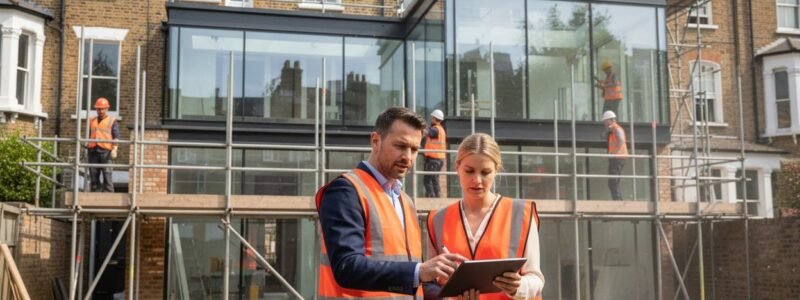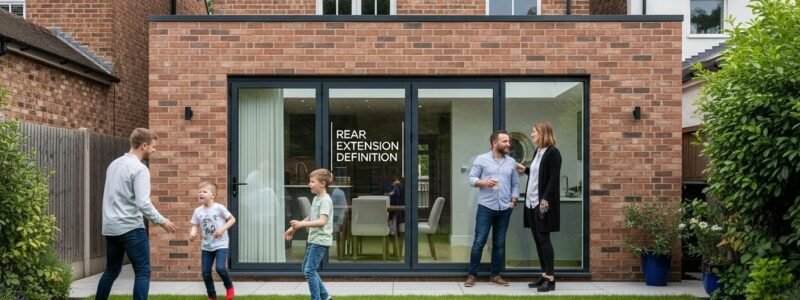Rear extensions are reshaping homes across the UK and are now a top upgrade for families craving more space and better living. Yet most people do not realise just how far these design trends have evolved. Classic brickwork remains trusted, but demand for glass box extensions, innovative bi-folding doors, and cutting-edge multi-functional rooms has surged and more than 40 percent of modern extensions now include open-plan living areas or home offices. It is not just about adding space anymore. The latest approaches transform how people work, relax, and connect indoors and out.
Table of Contents
- Classic Brick Extension: A Timeless Choice
- Contemporary Glass Box Extension: Maximising Light
- Open-Plan Living: Merging Kitchen and Dining
- Multi-Functional Spaces: Home Offices and More
- Bi-Folding Doors: Connecting Indoor and Outdoor
- Planning Permissions: What You Need to Know
- Budgeting for Your Rear Extension: Cost Considerations
Quick Summary
| Takeaway | Explanation |
|---|---|
| Classic brick extensions offer durability and charm | They provide long-lasting structural integrity and aesthetic appeal, enhancing property value and alignment with traditional styles. |
| Glass box extensions maximise natural light | By incorporating large glazing, these extensions create open spaces that connect indoor living with outdoor environments, enhancing visual transparency. |
| Open-plan living areas boost social interaction | Merging kitchens and dining spaces fosters connectivity, allowing for seamless movement and making compact areas feel larger and more engaging. |
| Multi-functional spaces adapt to lifestyle changes | Design considerations such as modular furniture ensure that areas can switch between work, leisure, and family activities efficiently. |
| Budget wisely for construction costs | Anticipate costs beyond initial construction, including materials and professional fees, and set aside a contingency fund for unexpected expenses. |
1: Classic Brick Extension: A Timeless Choice
The classic brick extension represents an enduring architectural approach that seamlessly blends traditional aesthetics with modern functionality. Homeowners seeking a timeless and robust solution for expanding their living spaces have long appreciated the charm and reliability of brick rear extensions.
Brick extensions offer substantial benefits that make them an attractive option for property improvements. These structures provide exceptional durability, remarkable thermal insulation, and a sense of architectural continuity with existing building styles. Explore home extension options in Islington to understand how these classic designs can transform your property.
Key advantages of classic brick rear extensions include:
- Excellent weather resistance and long-term structural integrity
- Superior sound and thermal insulation properties
- Enhanced property value and aesthetic appeal
- Potential for matching existing brickwork seamlessly
According to Homebuilding & Renovating Magazine, brick extensions remain a preferred choice for homeowners due to their ability to create harmonious architectural connections. The material’s versatility allows designers to craft extensions that complement the original building’s character while introducing modern design elements.
When planning a brick rear extension, consider the architectural style of your existing property. Matching brick types, understanding coursing patterns, and selecting appropriate mortar colours can create a cohesive and sophisticated result. Professional architects and builders can help you navigate these design nuances, ensuring your extension looks like an integral part of your home rather than an afterthought.
2: Contemporary Glass Box Extension: Maximising Light
Contemporary glass box extensions represent a transformative approach to home design, offering an elegant solution for homeowners seeking to introduce abundant natural light and create seamless connections between indoor and outdoor spaces. These modern architectural interventions have gained significant popularity among design enthusiasts who desire a minimalist, sophisticated aesthetic.
The primary appeal of glass box extensions lies in their ability to dramatically transform interior environments. By replacing traditional solid walls with expansive glazing, these structures invite natural light deep into living spaces, creating an atmosphere of openness and visual transparency. Homeowners can enjoy panoramic views while maintaining a strong connection with their garden or exterior landscape.
Key considerations for glass box extensions include:
- Selecting high-performance glazing with excellent thermal efficiency
- Ensuring structural integrity and professional installation
- Considering planning permissions and building regulations
- Balancing aesthetic design with practical thermal performance
According to Homebuilding & Renovating Magazine, contemporary glass extensions offer remarkable versatility. Modern technological advancements in glass manufacturing have addressed previous concerns about temperature regulation, with innovations like low-emissivity coatings and double or triple glazing providing superior insulation.
Architectural experts recommend carefully integrating glass box extensions with existing property styles. This might involve matching framing materials, considering sight lines, and ensuring the extension feels like a natural progression of the original building. Minimal framing and floor-to-ceiling glazing can create a stunning visual effect that makes the boundary between interior and exterior spaces almost imperceptible.
The result is not just an architectural feature but a transformative living space that enhances both the aesthetic and functional qualities of a home.
3: Open-Plan Living: Merging Kitchen and Dining
Open-plan living represents a revolutionary approach to home design, transforming traditional segmented spaces into fluid, interconnected environments. This architectural concept has gained substantial popularity among contemporary homeowners seeking flexible, multifunctional living areas that promote social interaction and maximize spatial efficiency.
The merger of kitchen and dining spaces creates a dynamic environment that goes beyond mere functional requirements. By eliminating physical barriers, homeowners can enjoy enhanced social connectivity while preparing meals, entertaining guests, and spending quality time with family. The design approach allows for seamless movement and visual continuity, making even compact spaces feel significantly more expansive.
Critical considerations for successful open-plan kitchen and dining extensions include:
- Thoughtful zoning to define functional areas
- Consistent design aesthetic and material selection
- Effective lighting strategies for different activities
- Intelligent storage solutions to maintain visual clarity
According to Homebuilding & Renovating Magazine, successful open-plan designs require meticulous planning. Professional designers recommend creating subtle visual transitions between cooking, dining, and living spaces through strategic placement of furniture, lighting, and architectural elements.
The practical benefits extend beyond aesthetic appeal. Open-plan layouts enhance natural light circulation, improve spatial perception, and offer greater flexibility for evolving family needs. Parents can supervise children while preparing meals, and hosts can engage with guests during dinner preparation, breaking down traditional kitchen isolation.
Modern open-plan extensions often incorporate innovative design elements such as kitchen islands, sliding glass partitions, and multi-level surfaces that create visual interest while maintaining functional versatility. The result is a contemporary living space that seamlessly blends cooking, dining, and social interaction into a harmonious whole.
4: Multi-Functional Spaces: Home Offices and More
The evolution of home design has dramatically accelerated, with multi-functional spaces becoming essential in modern rear extensions. Homeowners now seek flexible living areas that can seamlessly adapt to changing work, leisure, and family requirements, transforming traditional room concepts into dynamic, versatile environments.
Modern rear extensions are no longer simply about adding square footage but creating intelligent, adaptable living spaces that support diverse daily activities. These innovative designs allow individuals to work, relax, exercise, and entertain within a single, cohesive area, addressing the increasing demand for versatile home environments.
Key considerations for creating multi-functional spaces include:
- Flexible furniture with multiple uses
- Integrated storage solutions
- Clever lighting design to support different activities
- Acoustic considerations for noise separation
According to Homebuilding & Renovating Magazine, successful multi-functional extensions require careful planning. Designers recommend creating subtle spatial divisions using furniture placement, different floor levels, or partial room dividers that maintain an open, interconnected feel while providing functional separation.
The pandemic has accelerated the trend towards home-based work and flexible living arrangements. Rear extensions now frequently incorporate dedicated workspace zones that can quickly transform into dining areas, workout spaces, or relaxation zones. Sliding doors, movable partitions, and modular furniture enable rapid reconfiguration, ensuring spaces remain dynamic and responsive to changing needs.
Advanced design strategies include integrating technology infrastructure, ensuring robust WiFi coverage, incorporating multiple power outlets, and designing ergonomic work zones that blend seamlessly with residential aesthetics. The goal is creating spaces that are not just functional but also aesthetically pleasing, supporting productivity and well-being in a holistic manner.
5: Bi-Folding Doors: Connecting Indoor and Outdoor
Bi-folding doors have revolutionized home extension design, offering a transformative solution for connecting interior living spaces with exterior environments. These innovative architectural elements create seamless transitions, blurring traditional boundaries between indoor and outdoor areas while introducing exceptional natural light and spatial flexibility.
The remarkable appeal of bi-folding doors lies in their ability to dramatically open up living spaces, allowing homeowners to experience a sense of expansiveness and connection with their garden or exterior landscape. When fully opened, these doors create an uninterrupted flow, effectively extending living areas and creating a unified indoor-outdoor experience.
Key considerations for bi-folding door installations include:
- Material selection for durability and thermal efficiency
- Understanding track and frame configurations
- Evaluating opening direction and space requirements
- Ensuring professional installation and alignment
According to Homebuilding & Renovating Magazine, successful bi-folding door implementations require careful architectural planning. Modern designs offer multiple configuration options, from full-width glass panels to partially folding configurations that suit different architectural styles and spatial constraints.
Advanced bi-folding door technologies now provide superior thermal performance and security features. High-quality systems incorporate robust locking mechanisms, advanced weatherproofing, and energy-efficient glazing. Homeowners can select from various materials like aluminium, timber, or composite, each offering unique aesthetic and functional benefits.
Beyond aesthetic appeal, bi-folding doors represent a sophisticated architectural solution that enhances natural ventilation, increases property value, and creates a more dynamic living environment. They transform rear extensions from mere additional spaces into intelligent, adaptable living zones that respond to changing lifestyle needs and environmental conditions.
6: Planning Permissions: What You Need to Know
Navigating planning permissions represents a critical step in successful home extension projects. Homeowners must understand the complex regulatory landscape to ensure their rear extension meets local authority requirements, avoiding potential legal complications and costly retrospective modifications.
Planning permissions vary significantly depending on property type, location, and specific extension characteristics. While many rear extensions fall under permitted development rights, not all modifications can proceed without formal approval. The complexity of these regulations demands careful consideration and often professional guidance.
Key planning permission considerations include:
- Understanding your specific property’s permitted development rights
- Assessing extension size and potential impact on neighboring properties
- Checking conservation area or listed building restrictions
- Preparing comprehensive architectural drawings
According to UK Government Planning Guidelines, single-storey rear extensions have specific limitations. For detached houses, extensions beyond 4 metres require additional consultation, while other house types have a 3-metre threshold. These measurements are crucial in determining whether formal planning permission is necessary.
Homeowners should be aware that local planning authorities assess extensions based on multiple criteria. Factors such as height, proximity to boundaries, materials used, and potential impact on neighboring properties’ light and privacy all play significant roles in the approval process. Some areas have additional restrictions, particularly in conservation zones or for properties with specific architectural heritage.
Professional architectural services can provide invaluable assistance in navigating these complex requirements. They can help prepare detailed drawings, assess potential planning constraints, and increase the likelihood of successful permission applications, ultimately saving time and preventing potential legal challenges.
7: Budgeting for Your Rear Extension: Cost Considerations
Budgeting for a rear extension requires strategic financial planning and comprehensive understanding of potential expenses beyond initial construction costs. Homeowners must approach this significant investment with meticulous research and realistic expectations to avoid unexpected financial challenges during the project.
The total cost of a rear extension depends on multiple interconnected factors, making precise budgeting both complex and crucial. Professional estimates typically range from £1,500 to £2,500 per square metre, with variations based on design complexity, material selection, and specific site conditions.
Critical budget considerations include:
- Professional architectural and design fees
- Planning permission and building regulation costs
- Construction materials and labour
- Potential structural modifications
- Finishing and interior design expenses
According to Homebuilding & Renovating Magazine, successful budgeting requires anticipating potential additional expenses. Unforeseen challenges such as groundwork complications, drainage issues, or unexpected structural requirements can significantly impact overall project expenditure.
Homeowners should allocate a contingency fund of approximately 10-15% above the initial budget to manage unexpected costs. This financial buffer provides flexibility and peace of mind during the extension process, protecting against potential overruns and ensuring project completion.
Additional cost factors include the selection of high-quality materials, complexity of architectural design, and local labour rates. Urban areas like London typically experience higher construction costs compared to rural regions. Professional quantity surveyors can provide detailed cost breakdowns, helping homeowners make informed decisions and maintain financial control throughout the extension project.
Below is a comprehensive table summarising the main rear extension design concepts, benefits, and considerations outlined in the article.
| Rear Extension Feature | Description & Benefits | Key Considerations |
|---|---|---|
| Classic Brick Extension | Timeless appearance, structural durability, thermal and acoustic insulation, boosts property value | Matching existing brickwork, architectural continuity |
| Contemporary Glass Box Extension | Maximises natural light, creates sleek modern look, connects indoor and outdoor spaces | High-performance glazing, planning permission, heat control |
| Open-Plan Living (Kitchen & Dining) | Enhances social interaction, improves spatial flow, makes compact areas feel larger | Zoning, lighting, storage, consistent design aesthetic |
| Multi-Functional Spaces (incl. Offices) | Adapts to hybrid work and leisure, incorporates flexible furniture, supports evolving family needs | Dividing zones, integrated tech, ergonomic planning |
| Bi-Folding Doors | Seamlessly links indoor and outdoor areas, increases sense of space and ventilation, improved property value | Material & track choices, installation quality, security |
| Planning Permission | Ensures compliance with regulations, prevents legal issues, streamlines project execution | Permitted development rights, neighbour impact, documentation |
| Budgeting & Cost Management | Enables realistic financial planning, addresses hidden costs, includes contingency funds to avoid overruns | Professional fees, construction costs, unforeseen expenses |
Bring Your Dream Rear Extension to Life in London or Surrey
Are you inspired by the rear extension examples but feeling uncertain about turning your vision into reality? Many homeowners face challenges such as planning permission concerns, balancing modern design with practical needs, and managing project costs for classic brick extensions or glass box designs. The article highlights the importance of strong project management, architectural continuity, and adapting spaces for growing families or changing work requirements. If you are hesitating because of navigating regulations, controlling your budget, or choosing the right style that fits your home, you are not alone.
This is where our expertise makes the difference. At Reltic Extend, we specialise in bespoke home extensions throughout London and Surrey, handling every step from design and planning permission to construction and final handover. Take advantage of more than 20 years’ experience, clear pricing, and a 10-year structural warranty. If you want a project that is both beautiful and stress-free, get in touch now and discover how seamlessly your rear extension can transform your home. The sooner you start, the sooner you enjoy the home you have always wanted.
Frequently Asked Questions
What are the benefits of a classic brick rear extension?
Classic brick extensions offer excellent weather resistance, durability, superior sound and thermal insulation, and enhance property value while maintaining aesthetic continuity with existing buildings.
How can I maximise natural light in a glass box extension?
To maximise natural light in a glass box extension, select high-performance glazing, ensure minimal framing, and consider open-plan designs that allow for unobstructed views of the outdoor space.
What should I consider when designing an open-plan kitchen and dining area?
Key considerations include thoughtful zoning to define functional areas, consistent design aesthetics, effective lighting strategies, and incorporating intelligent storage solutions to maintain visual clarity.
How do I ensure compliance with planning permissions for my rear extension?
Understanding your property’s permitted development rights, assessing the extension’s size and impact on neighbours, checking for any conservation restrictions, and preparing detailed architectural drawings are essential to ensure compliance with planning permissions.





